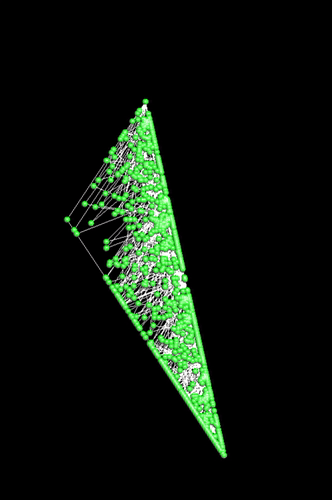-
Notifications
You must be signed in to change notification settings - Fork 139
BooleanOps

Geogram has functions to compute accurate intersections between triangulated meshes.
The boolean_op demo program
loads two meshes, applies a boolean operation to them, and saves the result. It is used as follows:
$ boolean_op operation=union|intersection|difference filename1 filename2 resultfilename
The corresponding functions are implemented in geogram/mesh/mesh_surface_intersection.h

The surface mesh intersection algorithm can also be used to tetrahedralize the interior of a collection of intersecting closed meshes. This operation is a bit different from the classical boolean operations, since one can optimize how to detect and discard internal boundary (in contrast with boolean operations that require a more complicated classification for all the triangles).
The figure shows (from left to right):
- a union of mutually intersecting closed meshes
- a cross-section, revealing many internal boundaries
- the computed intersection, with all internal boundaries removed
- the resulting tetrahedral mesh
The bundled vorpalite utility automatically does this pre-processing if the input mesh
has intersections:
$ vorpalite profile=tet inputfilename outputfilename
Internally, it uses the following functions:
mesh_repair(M, MESH_REPAIR_DEFAULT, epsilon);fill_holes(M, max_hole_area);MeshSurfaceIntersection intersection(M);intersection.intersect();intersection.remove_internal_shells();mesh_repair(M, MESH_REPAIR_DEFAULT, epsilon);
They are called iteratively until no intersection is found. This is needed for two reasons:
- geogram does not have (yet) a snap-rounding algorithm that ensures that the exact points snapped to double precision do not yield additional intersections.
- tetgen sometimes moves the points and generates additional intersections
A simple intersect example program is also provided, used as follows:
$ intersect inputmesh.obj <option1=true|false> .. <optionn=true|false>
It demonstrates
several options of the MeshSurfaceIntersection class,
described below:
| option | description | default |
|---|---|---|
| verbose | display lots of messages | on |
| Delaunay | triangulate intersected facets with Delaunay | on |
| detect_intersecting_neighbors | also test neigboring triangles for intersection | on |
| normalize | normalize coord in [0,1] before intersection | on |
| remove_internal_shells | only keep external skin of union | off |
| dry_run (debug) | do not store intersection, only compute it | off |
| monster_threshold=nnn (debug) | save facets that have more than nnn intersections | off |
The algorithm is implemented in MeshSurfaceIntersection::intersect(). It has the following steps:
- compute the list of candidate triangles, using an AABB tree. See also tutorial on AABBs
- compute the exact intersections between each pair of candidate triangles, see geogram/triangle_intersection.h
- re-triangulate the triangles that have intersections. This uses MeshInTriangle, a subclass of
the Constrained 2D Delaunay class that creates the new vertices in exact precision and that uses special predicates
Internally, this uses
vec2E,vec3E(vectors with arbitrary-precision coordinates stored asexpansion_nt), andvec2HE,vec3HE(same thing in homogeneous coordinates, which makes it possible to divide coordinates without dividing (one multiplies the homogeneous factorwinstead). - (optional) to implement boolean operations, triangles are sorted around non-manifold edges to indentify the formed 3D region. This is done by the RadialSort class.
Some meshes, like this one from Thingi10K have a huge number degenerate intersections.


This specific mesh is a bit special, it has dramatic modeling errors that created a 3D array of triangles intersecting in three directions, generating N^3 intersections. Although it corresponds to nothing in real life, it is a good benchmark to test the robustness of the algorithms.
The test base contains also more realistic (though challenging) cases, here, like this one with many degenerate coplanar triangles:


The co-planar regions are coherently triangulated, thanks to the uniqueness of the Delaunay
triangulation. The result can be filled with tetrahedra (in yellow on the second image).
The key is the implementation of the in_circle predicate,
here.
The result looks horrible ! Fortunately, the algorithm can optionally detect and re-triangulate the zones with co-planar triangles, as shown in the Figure below (see MeshSurfaceIntersection::simplify_coplanar_facets())

- Let's continue the journey with Constructive Solid Geometry.
- Want to learn more about how it works ? See this article.
To gain more speed and more robustness in the extreme cases, read about GeogramPlus.